Poster design for Hangzhou Asian Games highlights city's personality
 Richard Henderson. (PHOTO PROVIDED TO CHINA DAILY)
Richard Henderson. (PHOTO PROVIDED TO CHINA DAILY)
As the only foreign designer of the posters for the Hangzhou Asian Games, Richard Henderson highlights the vitality of color in his design.
Henderson, a well-known Australian designer, thinks that color is a universal device that humans respond to regardless of their background, language, and nationalities.
"The poster in Asia is a great communication vehicle, we don't do that so much here (Australia)," said Henderson, adding that poster design is not his core work in Melbourne, but he had been invited to participate in the visual design work of the 2008 Beijing Olympic Games before, "that's why the opportunity to do a poster for Hangzhou was such a privilege."
The first time he went to China was to talk to the designers about the Beijing 2008 Olympic Games. At that time he tried to make connections with China and he brought Chinese students into Australia to study.
Although he has never been to Hangzhou before, he did go to many other places in China, such as Beijing, Shanghai, Wuxi, Shenzhen, and Guangzhou, "the green of China with all the trees is absolutely amazing," said Henderson, "there's the care of the environment, there's the protection of some of the older buildings and things."
"We are seeing some of the cities in China becoming far more interested in light now, they are opening up, becoming a little bit more vibrant in terms of light," said Henderson, explaining why his poster is themed with colors.
He wants "the colors of Hangzhou to be contemporary, modern, fresh, and optimistic in a way that attracts the eye."
So when he was invited to participate in the poster design for the Asian Games, he said that he felt grateful and proud to be accepted into this Chinese design circle.
His design efforts were enhanced by becoming more connected to Chinese culture, which included having a Chinese assistant for several years to help reach a better understanding of the country.
He also has a keen interest in China's history, architecture, Chinese ceramics and artworks.
"We went on the website, we had a look at the city (Hangzhou), it is a beautiful, passionate and youthful city," said Henderson, describing his feelings for the main hosting city of the Asian Games-Hangzhou.
The waters and the temples of the city left a deep impression when he looked at pictures on the website; he said that "eastern philosophy is interesting."
 (PHOTO PROVIDED TO CHINA DAILY)
(PHOTO PROVIDED TO CHINA DAILY)
When talking about how he conceived of the concept for the poster, he said the idea of a lake is quite a unique thing for him and he also started with the image of a city from the air.
"I think it's all about the fact that when you go higher, you actually lose your own national identity and you become more international, and you're global, that's how I like to work," said Henderson.
"If you look at the design, the circle 'o' has got a blue center and it actually represents the lake," said Henderson, as the Xihu Lake is one of the most famous landmarks in Hangzhou.
"I think what we have done with this design is, we can't help being influenced by our own background, our own landscape, our own country here in Australia. But as designers, we can identify internationally with the way things should feel and the way things should look," said Henderson.
Henderson also shared his experience about cooperating with Chinese designers, as designers have a way of working together where language is not a problem, he said, "as a big listener, I get on very well with Chinese designers. I think Chinese designers are unbelievable, you're creating your own particular style. I really love it. I like to be associated with that sort of energy."
"We work on the sort of shape, color and feeling. I think that's probably for me the most satisfying part of working with Chinese designers and Chinese clients," said Henderson.
"Chinese design and Chinese fashion have now got their own look, it's not copying anything anymore, it's creating its own. I think that's a fantastic thing, the confidence, what I would call 'China pride', in what you can do," Henderson expressed his appreciation of this kind of maturity and confidence brought by Chinese designers and their ideas, as he said, "I think Chinese design is moving into a completely new era."
"I just love the way that the passion of sport and the effort that goes into being a champion is connected with art and design. Because I think the body is a piece of design," said Henderson.
For the organizing committee, combining design, art, culture, and sport together is a really great thing, "I wish that the Asian Games will absolutely be numero uno," said Henderson.
Besides Henderson's poster, another 37 posters of the Asian Games have also been exhibited. They were carefully selected from a total of 1,789 posters by designers who came from Asia, Europe, America, Oceania, etc.
According to Bi Xuefeng, Dean of the School of Design Art of China Academy of Art, three standards of evaluation were put into consideration when choosing the posters, including the generality of the poster's theme, the creativity to express the sports spirit, the artistic expression and visual experience.
Bi hopes that the poster design exhibition can get more people to pay attention to the Asian Games. "The poster exhibition is also a social aesthetic education, which can give the public a new understanding of visual art and poster art, and I hope to bring a new perspective to everyone's aesthetic experience," Bi added.
Fang Xiaoying in Hangzhou contributed to this story.


